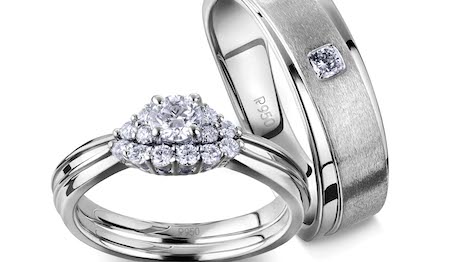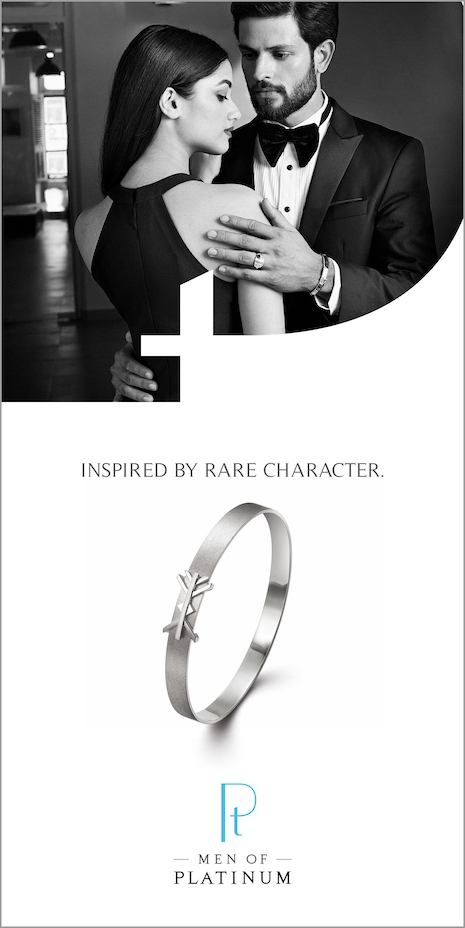- About
- Subscribe Now
- New York,
February 28, 2020

 Platinum Days of Love wedding bands. Courtesy of Platinum Guild International
Platinum Days of Love wedding bands. Courtesy of Platinum Guild International
Demand for platinum jewelry is on the rise in India as affluent Indian consumers seek more modern styles and more men seek out jewelry.
The element fabrication of platinum jewelry grew by a compound average growth rate of 8 percent in popularity in the region between 2013 and 2018, making India the fastest-growing platinum jewelry market in the world, according to the latest report from Platinum Guild International (PGI), the industry group that tracks platinum consumption. Jewelry makes up 7 percent of India’s GDP, and this rise in platinum consumption means opportunity for brands designing platinum jewelry.
“Different from gold jewelry, which represents wealth and tradition in the Indian culture, platinum in India has built aspiration and relevance among these young consumers by building differentiation from gold through a strong emotional and image-driven equity, since 2000 when PGI entered the market,” said Tim Schlick, chief strategy officer at PGI, Hong Kong.
 Tim Schlick is chief strategy officer of Platinum Guild International
Tim Schlick is chief strategy officer of Platinum Guild International
Equal partnerships
Younger consumers are influencing the demand for platinum jewelry in India.
By 2021, 61 percent of India’s 1.4 billion population is expected to be below the age of 35, according to the PGI report. These younger consumers are more educated and tech savvy than older generations.
New luxury materials including platinum are becoming popular among these groups of newly affluent Indians.
“India’s strong and embedded luxury jewelry culture has witnessed significant changes over the past decade,” Mr. Schlick said.
“These shifts have been fueled by demographic trends impacting consumption, a fast-changing socio-economic environment and a changing retail landscape,” he said.
Platinum has been a growing element for wedding bands in India, a symbol of love with a more modern connotation.
PGI has been marketing to the bridal segment with a campaign called, “Platinum Days of Love” (PDOL) focused on a couple’s wedding bands.
Using insights that younger couples are looking for more equality in their marriages, this effort has worked to establish platinum as a symbol of love among modern Indian couples.
In 2018, 64 percent of consumers targeted by PGI chose platinum wedding bands.
This marketing extends beyond just couples, and on to parental gift giving, which is a tradition in India.
The Evara jewelry line is positioned as a symbol of parental love for the bride’s parents to give to the couple. The line is designed to reflect a bride’s bond of love with her family.
“As PGI’s first branded category in India, PDOL has created the foundation of platinum’s presence, and firmly established platinum as a symbol of love in India,” Mr. Schlick said.
“The brand has built strong desire and preference among its core consumer group with values in a modern relationship to deepen the meaning of the rare love that platinum symbolizes, linking back to the rare attribute of the metal,” he said.
 Men of Platinum ad campaign. Courtesy of Platinum Guild International
Men of Platinum ad campaign. Courtesy of Platinum Guild International
Men of mettle
Platinum has a strong association with style and modernity among young men in India and is becoming the element of the younger more modern generations.
Jewelry made with the element comes off as more refined among consumers looking to show inner strength and social respect over flaunting wealth which metals such as gold are associated with, the report revealed.
“In India, men are fairly well immersed in the jewelry purchase,” Mr. Schlick said.
“There are multiple drivers for men’s jewelry, from being a socio-cultural norm to being a style accessory, a symbol of success and declaration of status,” he said.
In September 2019, PGI launched “Men of Platinum,” a new brand aimed at men in India who desire a more modern and understated look.
Advertising for this platinum jewelry represents more contemporary values and lifestyles within a specifically Indian context.
PGI aims to push its distribution network for platinum jewelry in the coming years.
“PGI India officially launched Men of Platinum based on the insight that in an increasingly affluent world, the accumulation of wealth alone can no longer equate to one’s stature in life,” Mr. Schlick said.
“Men of Platinum showcases men with rare character – the values they follow are hard to abide by and for them success comes from achieving personal greatness,” he said.
The men in the black-and-white ad campaign are young, modern and affluent, and “inspired by rare character,” as the ad suggests.
PGI has taken a phased approach to market development for men’s platinum jewelry in India.
In phase 1, PGI targeted the top nine metro cities in India with its marketing program.
Additionally, strategic partners expanded the reach for the brand by investing in marketing outside the PGI focus markets.
This enabled the brand to reach 500 stores within four months of launch, ahead of the campaign’s goals.
Going forward, PGI aims to accelerate the growth for the brand by targeting 6 million men in high-affinity consumer segments for platinum jewelry in the region.
“Men of Platinum is an opportunity PGI developed in partnership with key strategic partners in India, to leverage a new consumer segment which offers an incremental ounce opportunity through higher average weights,” Mr. Schlick said.
“Men of Platinum has been conceptualized after intense and in-depth consumer research and in market testing,” he said. “PGI India had tested the men’s jewelry category opportunity with its key strategic partners to measure its potential and saw immense success.”
Share your thoughts. Click here